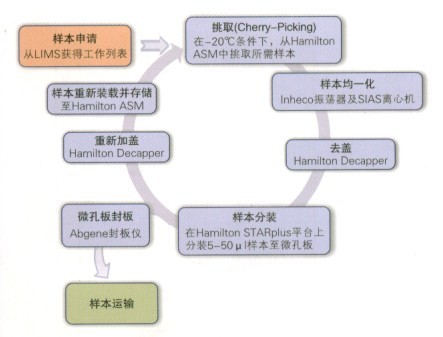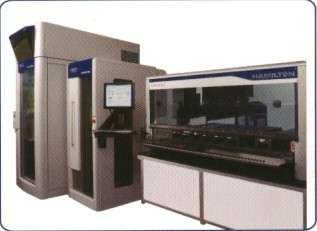Automated solution for the Estonian Genome Center Biological Sample Library
Overview
The Estonian Biological Samples Library is a collection of nationally based biological samples that represent the entire Estonian population. Because of the overall workload, reaction time, sample integrity and process safety, it is becoming more and more difficult to manually distribute samples for research partners. Therefore, the Estonian biological sample library uses an automated storage system, an automation system. A Hamilton processing center consisting of a liquid handling system and a number of small devices such as centrifuges and cappers to automate the entire sample transfer process.
Introduction
Founded in 2001, the Estonian Biological Samples Library is a nation-based biological sample library affiliated with the Tartu University Genome Center (EGC). The sample bank collects donor samples that represent the entire Estonian population. To date, plasma, DNA, and buffy cells from 52,000 donors have been collected and their health data collected. The biological sample library is responsible for preparing, storing and providing these samples and for quality control of the stored and supplied samples. Estonia's biological sample library uses automated systems to increase throughput, maintain sample integrity and improve process safety. They achieved full automation of sample extraction and supply in 2012.
Traditional workflow
Sample supply: DNA was manually aspirated by a pipette, transferred to a deep well plate, and frozen in a -20 ° C common refrigerator. After the application was made by the investigator, the microplate containing the desired DNA sample frozen at -20 °C was melted, manually transferred to a transport plate and distributed to the appropriate investigator.
Once the DNA is used up or expires, more samples from the liquid nitrogen reservoir are needed to extract new DNA. All processes are documented in accordance with the ISO 9001-2008 implemented and customized Laboratory Information Management System (LIMS).
challenge
Manual processes require a lot of manpower and time. Laboratory technicians could have spent these hours on more important research work. Even if only one sample is needed, the entire plate must be melted, manually opened and picked, so for the integrity of the sample, repeated freezing and thawing of a large number of samples also increases the risk of accidents and mutual contamination between samples. Steven Smit, head of EGC Labs, said: "We are working hard to increase the sample supply rate by more than 10 times."
Figure 1: Hamilton ASM (left) and STAR (right) integration
Hamilton solution
The solution to increase the sample supply rate and reduce human error is to automate the entire DNA dispensing process and transfer the sample from the microplate to the 2D barcode-labeled cryotube for intermediate storage, reducing the number of freeze-thaw cycles and improving sample integrity. Sex. The ASM automated sample storage system can store 99,800 cryotubes with 2D barcodes and sample sorting at -20 °C. Therefore, as long as the required sample is transferred to room temperature, the other samples are still frozen in the ASM system.
A pick list of samples required by the LIMS database when preparing samples to be issued. The relevant samples were picked-up by ASM and placed in a transport carrier, which was then melted by the ASM system's server and then automatically transferred to the Microlab ® STARplus automated liquid handling system for subsequent operations.
The ASM picking good carrier was first transferred to the shaker and shaken at 750 rpm for 20 seconds to achieve homogenization; then centrifuged at 1000 rpm for 20 seconds in a centrifuge to precipitate the liquid from the tube cover and the tube wall, followed by Hamilton. The DeCapper capper removes the cryotube cap, followed by a 5-50 μL sample with STARplus, which is then capped with the original cap and transferred back to the ASM for storage. Finally, the newly created 96-well plate was sealed with a heat sealer and retained on the STARplus table.
The only manual step in the process is to remove the prepared shipping version for downstream research.
In addition, STAPplus can also be used for sample dilution, PCR plate preparation, and more.

Figure 2: Basic workflow of the Estonian Biological Sample Library
summary
The user fully automates the DNA sample supply process by using Hamilton's total solution. One of the biggest benefits of this workflow is the ability to perform a cherry-picking at -20 °C, ensuring that only the required samples are melted without melting all of the samples.
Laboratory director Smit said: "This greatly reduces the number of freeze-thaw cycles of the sample and minimizes the time the sample is at room temperature. We hope to extend the life cycle of each sample."
The use of the Hamilton automation system greatly reduces the amount of manual work, allowing researchers to gain more time for more meaningful research and substantially eliminating the risk of sample contamination or confusion. Moreover, you can easily increase the storage capacity of the ASM system by adding up to 3 ASM storage modules to meet the future needs of customers.
Soft Mist Inhaler
The Anomatic series of high-quality deep drawn Aluminum Canisters is designed to be compatible with your chosen valves, Actuators and drug formulations. Our deep drawing process ensures a consistent side wall thickness using high strength aluminum which is far superior to other forming methods. The aluminum is work hardened during the deep draw process and the surface mechanically polished providing a smooth, hard internal finish suitable for use with both CFC and HFA propellants.
Aluminum anodization is an electrochemical process that enhances the strength, durability, and appearance of aluminum. When aluminum is oxidized, super-strong oxide (anodic) layers [grow" on the surface of the metal. These new layers are highly resistant to wear and corrosion.
The exacting part to part consistency achieved with our unique anodizing system cannot be obtained with conventional hoist line systems. Conventional anodizing systems present parts with varied coating thicknesses and voids formed due to air pocketing.
A consistent uniform 6 µm anodic film thicknesses will protect certain drug formulations and the canister from degradation. Heavier film thicknesses of up to 12µm can be provided to meet your more demanding application.
soft mist,Soft Mist Inhaler,soft mist inhaler brands
Anomatic(suzhou)metal packaging co,ltd , https://www.anomaticpharma.com

